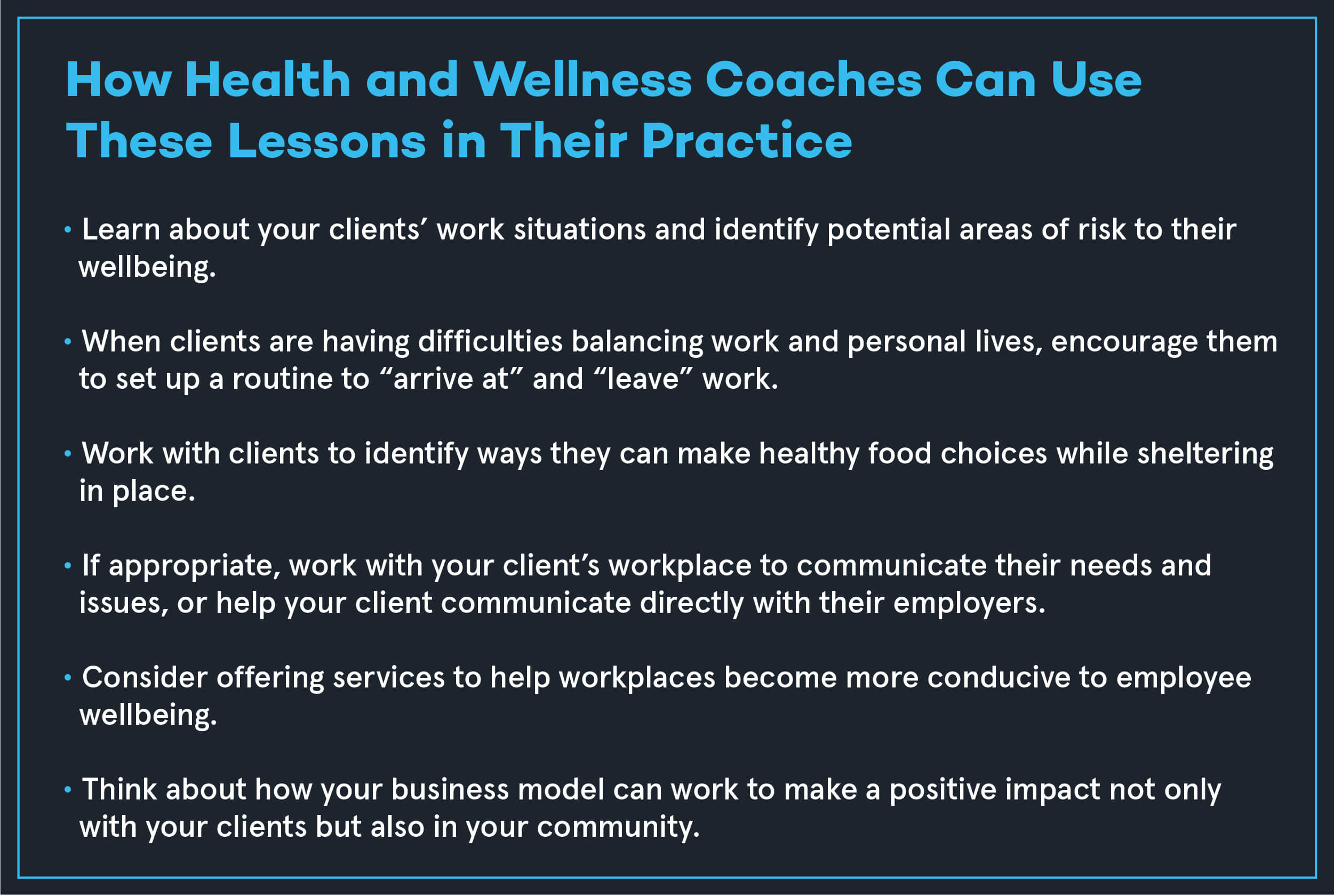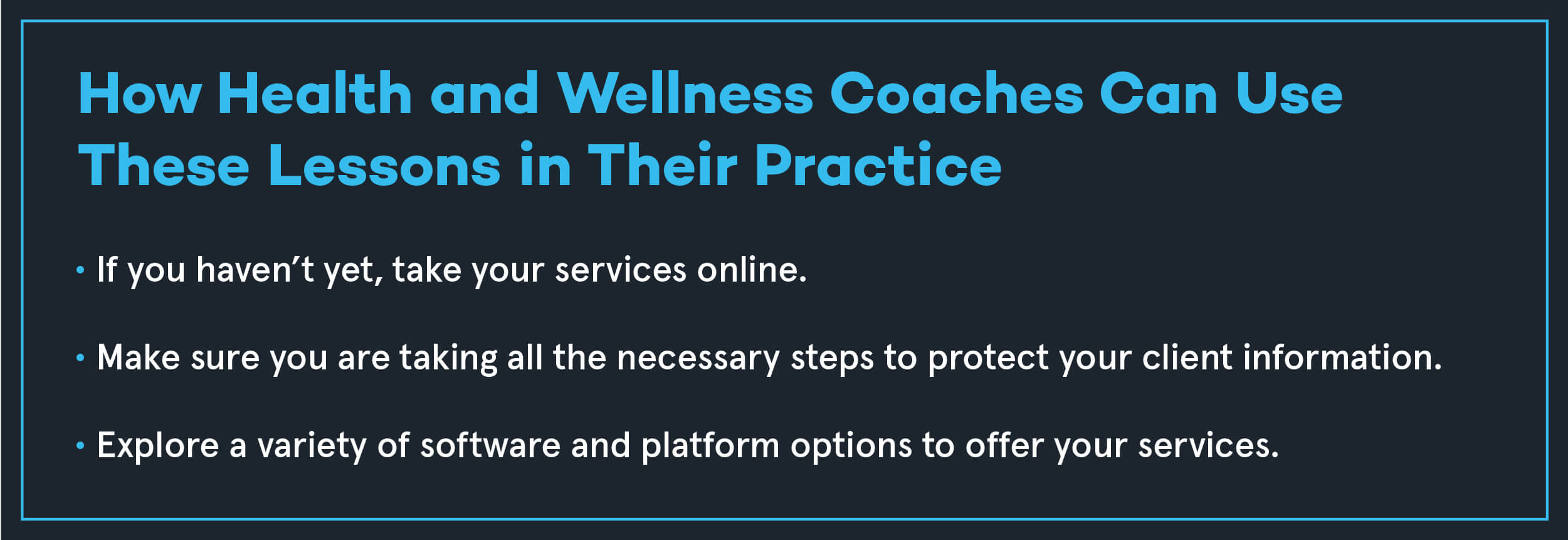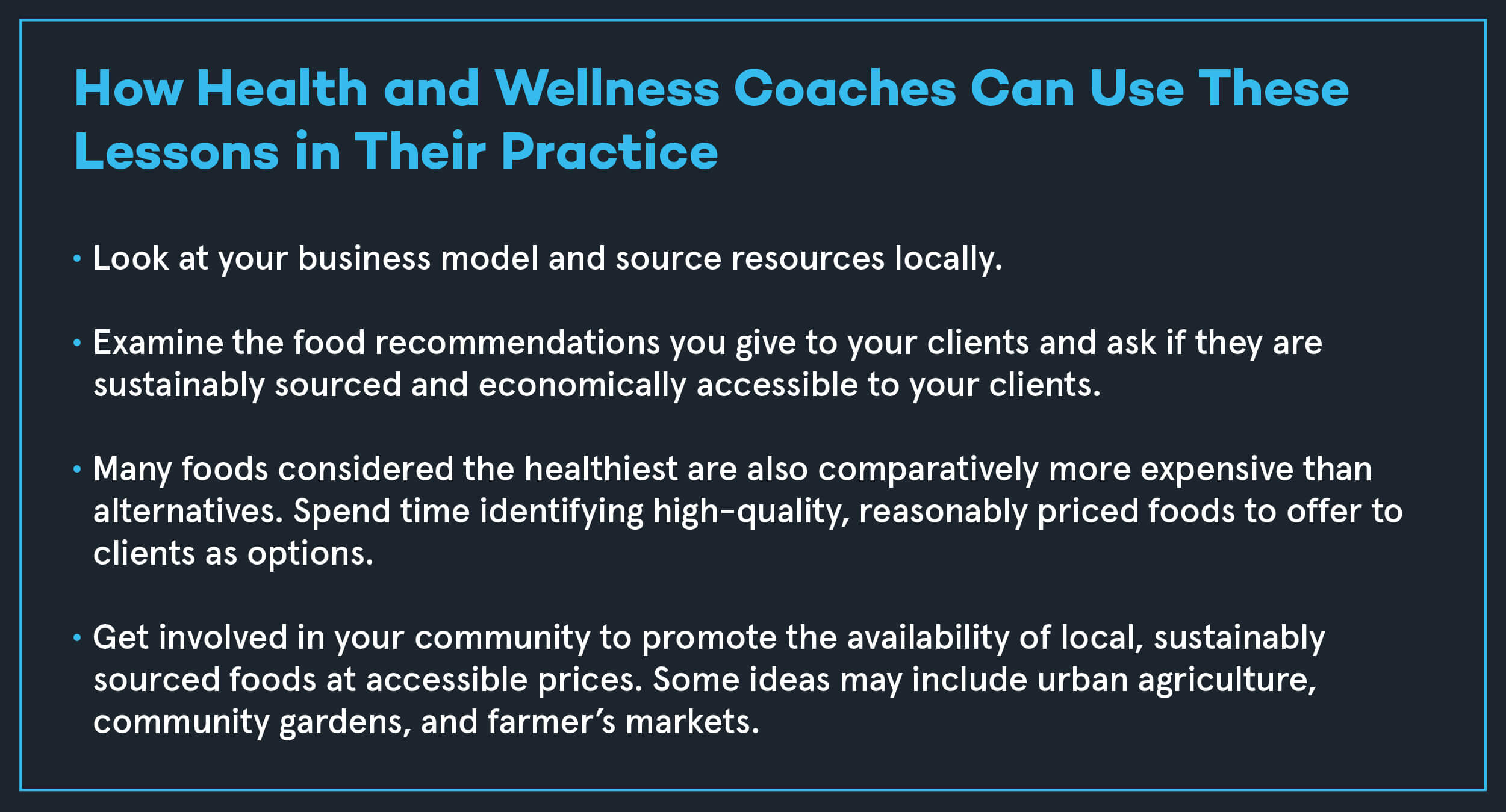2020 has been a year of challenges, pain, and transformation in numerous forms. Most industries have experienced difficult, unprecedented changes and have been obligated to look inward to find ways to adapt to changes and be part of the solution in a time of need. The health and wellness industry is no exception, as the year 2020 leaves us many lessons on which to reflect and take action.
This article is a continuation of last week’s article, which reflects on the events of 2020 and presents the first three lessons the year leaves us with. In this article, we present four more lessons that this year has left the health and wellness industry.
Work Environments Have an Important Role in Health and Wellness
The Background
A person’s workplace is more than a place to make money. It provides social interactions and intellectual growth, influences emotional wellbeing, and creates a space of respect for (or lack thereof) spirituality and culture. For the last few decades, it was well-known that our workplace could have a negative impact on our physical wellness by increasing our sedentarism or being extremely risky or physically demanding. Now, however, companies and organizations have been forced to see how their workplaces have a role in spreading COVID-19.
If you aren’t sure what the definition of wellbeing is, we encourage you to read lesson number four in this article.
After nonessential workers were sent home and encouraged to set up home offices, employees started working longer hours and have had difficulty separating work and personal lives.
The Lessons
Employers have a vital responsibility to create an environment conducive to their employees’ health and wellbeing. This may include offering flexible work options to employees, updating practices to understand their role in health and wellbeing and creating a positive environment that will allow employees to contribute their talents in the long run, and ensuring they have the tools to work in a secure and hygienic work environment.
Companies and businesses have the potential to make a significant impact on addressing systemic problems and promoting health in their community through their use of local businesses, sustainable and eco-friendly supply chains, and making donations to grassroots organizations and community members in need.
How Health and Wellness Coaches Can Use These Lessons in Their Practice
- Learn about your clients’ work situations and identify potential areas of risk to their wellbeing.
- When clients are having difficulties balancing work and personal lives, encourage them to set up a routine to “arrive at” and “leave” work.
- Work with clients to identify ways they can make healthy food choices while sheltering in place.
- If appropriate, work with your client’s workplace to communicate their needs and issues, or help your client communicate directly with their employers.
- Consider offering services to help workplaces become more conducive to employee wellbeing.
- Think about how your business model can work to make a positive impact not only with your clients but also in your community.

Well-Designed Online Health Services Help Keep People Healthy, Active, and Safe
The Background
Social-distancing, stay-at-home orders, lockdown, and sheltering-in-place practices have come to revolutionize the way we work, study, socialize, and take part in cultural events.
In many ways, we are fortunate that these requirements have come at a time where the creation of and use of digital platforms was becoming increasingly prominent. As one group of researchers described, within only a few weeks, the COVID-19 pandemic “accelerated the adoption of digital solutions at an unprecedented pace, creating unforeseen opportunities for scaling up alternative approaches to social and economic life.” In fact, digital platforms have been seen as essential to wellbeing and health during the pandemic.
The digital revolution expanded to the healthcare world as COVID-19 restrictions and precautions, together with patient needs, transformed how healthcare was delivered. Between March 2 and April 14 telemedicine visits increased by 683%, with a particularly high utilization of telemedicine for urgent care.
At the same time, a surge of activities online brought threats and challenges on an organizational and governmental level, with a need for greater regulations that address the ethics of information access and artificial intelligence, all the way down to the individual family level, where a greater online presence of all family members results in increased exposure to risks.
Social media has also expanded in light of the BLM movement and the US elections. While there is still widespread debate about how well it is currently being implemented, social media, when used responsibly, could be an effective tool for change and information.
The Lessons
The acceleration of new digital solutions as a result of the COVID-19 era leaves us with five main lessons:
- Access to digital tools needs to spread across industries.
- The expansion of telemedicine should be directed in a way to fill the void of physical and economic access to healthcare.
- There is a need for the creation of digital tools and alternatives for all industries, including for the variety of health and wellness practitioners.
- There is an urgent need to keep entrepreneurs, families, and individuals safe from digital threats like hacking, misinformation, misconfiguration, scams, cyberbullying, and cyber predators.
- E-learning managers and instructors must take into account factors critical to success for digital program design.
How Health and Wellness Coaches Can Use These Lessons in Their Practice
- If you haven’t yet, take your services online.
- Make sure you are taking all the necessary steps to protect your client information.
- Explore a variety of software and platform options to offer your services.

Current Food Systems Put the Population at Risk of Food Insecurity
At the beginning of the COVID-19 pandemic, news of potential lockdowns spread across communities, and panic took over large sectors of the population who lined up outside supermarkets only to find shelves void of toilet paper, cleaning supplies, and shelf-stable food.
Not only has the COVID-19 pandemic led to the devastating loss of human life and extreme stress on health systems, but it has also challenged current food systems.
The United Nations ILO, FAO, IFAD, and WHO put out a joint statement in October where they stated, “The pandemic has been affecting the entire food system and has laid bare its fragility.”
Some of the worldwide data are as follows:
- Tens of millions of people are at risk of falling into extreme poverty.
- The number of undernourished people was estimated to increase up to 132 million by the end of 2020.
- Nearly half of the world’s 3.3 billion global workforce is at risk of losing their livelihoods.
- “Border closures, trade restrictions, and confinement measures have been preventing farmers from accessing markets, including for buying inputs and selling their produce, and agricultural workers from harvesting crops, thus disrupting domestic and international food supply chains and reducing access to healthy, safe and diverse diets.”
- Millions of agricultural workers worldwide have worked nonstop to feed the world but often face poverty, malnutrition, poor health, lack of safety and labor protections, and many other types of abuse.
- The pandemic highlighted cracks across the food system, including production, processing, distribution, and consumption. These have resulted in variable prices, labor shortages, and reductions in food quality.
US populations are also facing unprecedented food insecurity.
- The states with populations at greatest risk of food insecurity include Mississippi at 22%, Arkansas at 20.5%, and Alabama at 20.3%.
- Massachusetts, New Jersey, and Nevada experienced the highest percent changes in food insecurity from 2018 to 2020, at 59% and 56%, respectively.
- Latinx, Native American, and Black communities, who were already more vulnerable to food insecurity than white populations, are also more vulnerable to spikes in food insecurity as a result of the COVID-19 pandemic.
The Lessons
COVID-19 represents a convergence of crises from public health, employment, labor, food delivery, and food safety, all of which lead to food insecurity.
Food systems across the globe need to be examined to ensure:
- Protection for essential workers in the food system
- Price stabilizers
- Food reserves for emergencies
- Diversified sourcing
- Support for local agricultural production and processing
Now, more than ever, is the time for solidarity with communities, especially those most vulnerable to food insecurity.
How Health and Wellness Coaches Can Use These Lessons in Their Practice
- Look at your business model and source resources locally.
- Examine the food recommendations you give to your clients and ask if they are sustainably sourced and economically accessible to your clients.
- Many foods considered the healthiest are also comparatively more expensive than alternatives. Spend time identifying high-quality, reasonably priced foods to offer to clients as options.
- Get involved in your community to promote the availability of local, sustainably sourced foods at accessible prices. Some ideas may include urban agriculture, community gardens, and farmer’s markets.

Final Reflections
The very nature of reflection is looking back on what has happened in the past. Just as reflection is an essential part of effective coaching and the health behavior change process, reflection is also an important part of making sure businesses stay relevant. As we spent time reflecting on the year 2020 and how we have contributed to filling information and resource gaps for coaches, your clients, and the public in general, at AFPA, we couldn’t help but look back at our predicted trends in nutrition and health coaching for 2020.
Despite the fact that we would have never been able to predict a global pandemic that devastated communities and nations, we look back on the predicted trends from 2019 and find that most of the trends were steadfast.
Microbiome health, the role of food in immune response, the importance of work environments that support mental and physical health, and a greater focus on the food chain were all predictions we made for 2020 that not only came to fruition but also had much greater importance than experts could have predicted.
We move forward into a new year where the challenges brought on by 2020 are carried into 2021. As a health, nutrition, and wellness community, it is important that we reflect on what we have learned over the past several months to be better equipped to promote health in ourselves and our communities.

Get Your Free Guide
Learn How to Start a Fulfilling, Impactful Career as a Holistic Health Coach
You’ll learn:
- Why holistic health matters
- If holistic health coaching is right for you
- What career opportunities exist for health coaches
- And more!



